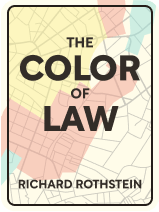

This article is an excerpt from the Shortform book guide to "The Color of Law" by Richard Rothstein. Shortform has the world's best summaries and analyses of books you should be reading.
Like this article? Sign up for a free trial here .
How did federal housing policies enable racial segregation in housing? What is the impact of racial discrimination in housing?
Federal housing policies mandated that public housing projects must reflect the racial composition of the neighborhoods around them. This created an environment where African Americans and whites lived in distinct enclaves. Racial segregation has had a destructive impact on Blacks, contributing to wealth inequality and poverty.
Read on to learn more about how the government facilitated racial segregation in housing.
How Public Programs Facilitated Racial Segregation in Housing
One of the most significant methods the federal government used to institute racial discrimination in housing was public housing policy. Throughout much of the 20th century, federal housing was segregated by race, and rules mandated that units for African Americans be built in predominantly African American areas and units for whites be built in predominantly white areas. These rules entrenched racial segregation in housing that, but for the discontinuance of segregated public housing, could have remained—or been further—integrated.
A History of U.S. Public Housing
In the contemporary imagination, public housing—or “projects,” as they’re colloquially known—is composed of dreary high rises, largely occupied by families of color headed by single mothers. This stereotype isn’t true: Present-day public housing can consist of attractive low-rise structures and count whites and BIPOC alike among its inhabitants. In fact, at least in its early history, public housing was the exclusive province of whites.
The first public housing units were built during World War I to accommodate war-industry workers. In this era, 83 projects housed 170,000 (white) workers. Although African Americans worked in the war industries in large numbers, they were excluded from these units.
Later, during the Great Depression, President Franklin Delano Roosevelt inaugurated a housing program under the aegis of the Public Works Administration (PWA) to ease a nationwide housing shortage. As was the case with other New Deal programs like the Tennessee Valley Authority (TVA) and the Civilian Conservation Corps (CCC), whose workers’ camps and villages were strictly segregated, the new housing program’s rules further enabled racial discrimination in housing. For example, of the PWA’s 47 housing projects, 17 were assigned exclusively to African Americans, 6 were integrated but segregated by building, and the remaining 24 were designated for whites only.
These projects also had to abide by what then-Secretary of the Interior Harold Ickes called the “neighborhood composition rule.” According to this rule, a project had to reflect the racial composition of the neighborhood around it: Projects located in white areas had to be exclusively white, projects located in Black areas exclusively Black, and so on.
The problem with the “neighborhood composition rule” was that it exacerbated city planners’ segregation efforts. In Miami, federal officials agreed to build an African American project in an area zoned specifically for Black residents. And in Atlanta, where the first PWA project was built, an integrated neighborhood called the “Flats” was demolished to make way for a whites-only project. The displaced African Americans were forced to rent rooms in other African American neighborhoods or move in with relatives, eventually creating the population density that turns neighborhoods into slums.
Similar trends of racial segregation in housing repeated themselves in St. Louis, Cleveland, Detroit, Indianapolis, Toledo, and New York: Integrated neighborhoods comprising white immigrants from Europe and African Americans were upended and segregated by the arrival of white- or Black-only public-housing projects.
From the Federal Government to the States
When Congress ended the PWA program in 1937, it established the U.S. Housing Authority (USHA) to provide subsidies to states and localities building public housing. The USHA’s subsidy policies echoed those of the PWA: Federally subsidized projects should reflect the racial makeup of the surrounding community.
Austin, Texas, provides a signal example of the effects of this policy. Projects for African Americans were built on the east side of the city, whereas projects for whites were confined to the west side. This outcome was driven by segregationist city planners, who’d aimed to shift the city’s African American inhabitants to the east side.
Public Housing During World War II
Given that military units were segregated during World War II, it should come as no surprise that public housing built to accommodate war-industry workers was segregated as well.
In Richmond, California, a town near San Francisco that hosted the biggest shipbuilding operation of the era, not only was racial segregation in housing the norm, but projects built explicitly for African Americans were located near the work site and featured shoddy materials intended to be temporary, whereas housing for white workers was built further inland with stronger materials.
White workers in Richmond were also eligible for the government’s “war guest” program, which leased rooms from private homeowners. The program also issued low-interest loans to homeowners for home remodels or expansions to accommodate lessees. These programs were for white homeowners and workers only.
Public Housing After World War II
Racial segregation in housing continued after the war as well. For example, in Boston, the Mission Hill projects were as segregated as similar public institutions in the deep south. There were two Mission Hill projects: Mission Hill and Mission Hill Extension. In 1967, despite a city-government promise to desegregate the two entities, Mission Hill was still 97% white whereas Mission Hill Extension was 98% Black.
In Detroit, politicians like Mayor Edward Jeffries based their campaigns around stoking whites’ fears of integrated public housing. Jeffries’s campaign distributed leaflets in white neighborhoods that appeared to (1) come from his opponent and (2) address African Americans. The leaflets read, “Negroes can live anywhere with [his opponent] mayor.” Later, in 1949, Jeffries’s successor vetoed seven integrated projects because they would have been located in predominantly white neighborhoods.
San Francisco’s public housing authority operated similarly to Boston’s, building segregated projects during and after the war that reflected the surrounding community’s racial demographics. In 1949, under pressure from civil rights groups, the authority adopted a compromise policy: It would fill vacancies in future projects without consideration of race, but it would maintain currently segregated projects.
In 1952, when the authority tried to build a new segregated project, the NAACP took the authority to court. The authority’s chairman admitted during testimony that the agency was purposely trying to confine African Americans to particular locations in the city.
The judge ruled against the authority, writing that the segregationist policy violated the Fourteenth Amendment. Forced to provide integrated housing, the authority found a workaround: Rather than integrate already existing projects, it built three new ones for African Americans in seemingly “white” areas, but whose white residents were actually starting to leave. This effectively reinforced segregation in these neighborhoods. A more faithful following of the court ruling would have integrated the all-white projects in the white areas of the city, slowing the segregation of San Francisco overall.
Federal Housing Policy in the 1950s
The government’s support for racial segregation in housing remained constant in the decade after the war. In 1949, spurred by thousands of returning GIs, Congress passed the Housing Act, which reestablished a federal housing program. To get the necessary votes from southern Democrats to pass the Act, northern Democrats had to strip the law of any integration amendments. The Act as passed permitted local authorities to segregate within or between projects.
The funds from the Housing Act went to establish segregated high-rise projects like Rosen Homes and Schuylkill Falls in Philadelphia, Van Dyke Houses in New York, and Robert Taylor and Cabrini Green Homes in Chicago. Many of these projects still exist (and remain segregated).
In 1952, the Truman administration attempted to reduce the inequities caused by segregated public housing by adopting a new rule: Local housing authorities receiving federal funds had to build Black-only housing projects in proportion to need. All too often vacancies in white-only projects were left unfilled—due to whites’ higher incomes and better treatment in the private real estate market—whereas long waiting lists for Black-only projects were common. The rule would force localities to build new units to satisfy existing need among African Americans.
However, with the election of Dwight D. Eisenhower, and the Republican Party’s adoption of a segregationist stance, any incrementalist steps toward a more equitable public housing policy were ended. The Eisenhower administration did away with a policy that mandated that housing for African Americans and whites be of equal quality. Likewise, they stopped enforcing Truman’s policy of addressing housing need, regardless of race.
Housing Fights of the 1960s and 1970s
By the 1960s, which inaugurated a booming private housing market for white families, public housing projects were predominantly occupied by African Americans. Because discrimination by race within the projects was no longer a factor—because whites no longer needed to live in public housing—civil rights groups turned their attention to where new builds were being located. They fought to prevent new housing projects from being situated in already segregated neighborhoods.
A key example of this shift occurred in Chicago. In the early 70s, the Chicago Housing Authority (CHA), the Department of Housing and Urban Development (HUD), and the City of Chicago all prevented new projects from being built in predominantly white areas. Civil rights groups sued, and a 1976 Supreme Court ruling, which upheld a lower court ruling, found the agencies’ behavior to be discriminatory and unconstitutional. The crux of the case was a particular policy that allowed individual ward aldermen to veto public housing in their areas. Aldermen in white areas, who didn’t want their areas integrated, vetoed housing units 99.5% of the time.
Similar discriminatory policies were followed in other cities, including Baltimore, Dallas, Miami, and Yonkers, NY.

———End of Preview———
Like what you just read? Read the rest of the world's best book summary and analysis of Richard Rothstein's "The Color of Law" at Shortform .
Here's what you'll find in our full The Color of Law summary :
- How racial residential segregation is the result of explicit government policy
- The three reasons why racial segregation is so difficult to reverse
- The steps that could lead to a more integrated and equitable society






